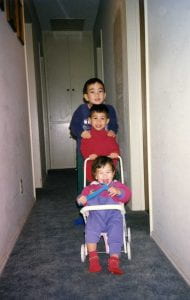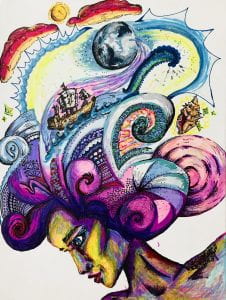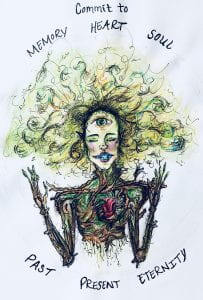Izzie Villanueva, TCCS Student ‘19
Editor’s note: In fall semester of 2017, Izzie Villanueva curated a zine for TCCS 610: Topics in TCCS offered by Aminah Pilgrim, Senior Lecturer of Africana Studie and core faculty of the Transnational Cultural and Community Studies program at UMass Boston. The following post is about this zine.
Playing off an abbreviation of “magazine”, zines are becoming an increasingly popular publication medium for artists, poets, and more. Zines are alternative publications to spread knowledge, narratives, and truths. Currently, many activists look to this platform to spread awareness on a variety of issues, combat inequities, and simultaneously advocate for their rights to exist and create communities. The presented zine incorporates the knowledge of community organizing and identity-validation to disrupt the oppressive ivory tower of higher education.

I used the image from our TCCS handbook as the overall cover of the zine. By blurring the image (especially blurring the outlines of a cityscape and buildings that was there previously) and enhancing the opacity of the colors, I wanted to reflect on how the pieces presented in the zine have their own differences, but still come together to collectively create one tangible piece of art. Furthermore, this symbolizes how my cohort and I have all come from different walks of life but are now together in the TCCS program.

I started this zine by incorporating poetry by my classmates Jimena and Taina (whose work appears above left and right, respectively) as they reminisce upon their homeland as they transition to the United States.
For Jimena’s piece, the background is an image I found in a fashion magazine of woman of color shaving her armpit hair. After reading Jimena’s piece, I thought about how blue is socially constructed to be the opposite of red.
I thought about how femininity is socially constructed, influenced by different ethnic cultures, but usually automatically linked to womanhood. I also thought about the things that are supposedly unallowed on a woman’s body such as hair or menstruation blood.
Is a nation state inherently tied to womanhood as it is depicted as one’s ‘motherland’? If she is drowning will others save her or will they simply say the water is simply tears and she is being overly emotional?
For Taina’s piece, I envisioned a letter being sent thousands of miles away; not only does the letter supercede human-imposed borders, it travels through land, sea, and time. Taina had informed me this piece was written several years ago and no longer held much relevance to her current life.
I argue, this is the beauty of poetry and reclaiming one’s narrative; when each piece of poetry is created, it holds relevance and significance of a specific moment in time and life.
I used an actual cardstock letter to illustrate this stagnant moment, but also consider how one’s interpretation as person moving in the diaspora, is always changing.

Continuing, I incorporated pieces by Myles and Grace (above left and right, respectively) to critically assess the word ‘America’. The image behind Myles’s piece is a white man wearing a red and white shirt with blue jeans.
Although not explicitly clear, it symbolizes the secret pervasiveness of colonialism that fuels ‘American culture’ and white supremacy – just because one cannot see it, does not mean it is not there.
Grace’s photo is essential in showing what the Americas truly are and subverts what U.S.-centric media portrays it to be. Both pieces are held together by a question mark sticker and a sticker of the American flag to question the validity of ‘Americanness’ as depicted by the U.S.

Pieces by Jimena and Jeanette (above left and right, respectively) are incorporated to continue thinking about ‘Americanness’ and what is expected in regards to language.
Many of us first generation immigrants or second generation children might have grown up with the rule of not speaking English at home; yet, the education system of the United States imposes this language, leaving us either confused or forced to forget our native tongue.
For Jimena, she previously abhorred speaking in English in Costa Rica, but now is forced to use it as her primary language. Whereas for Jeanette, she felt strange speaking in Spanish in a classroom setting because of how ingrained European settler colonialism permeates in the K-12 education system of the United States. The background is scattered with stickers one might find given to assignments for (native English speaking, adhering to colonialism, aligning with the system) elementary school students.

These pieces by Fernanda and Juan (above left and right, respectively) demonstrate the stark contrast of how others perceive assimilation and how it actually is in practice. Assimilating to a new nation should be sweet and seemingly easy to transition into with new identities easily assigned and adhered to (the bunnies for Fernanda’s piece hold complacent faces as they take in their new environment and eat the sweets of capitalism, not daring to question the process). Yet, even when this is supposedly achieved, more confusion appears as navigating ones new identities is no where near simplistic.
Juan’s piece is on different pieces of paper that must be flipped up to be read fully and the background is a space galaxy.
This symbolizes the seemingly never ending quest to understanding nationality, ethnicity, and how they play into one’s understanding of lived experiences and identity.

I wrote these two pieces at the end of the summer, right before moving to Boston. For the first piece, I used images of some of the students I have worked with in the past as a physical reminder of some of the communities I am pursuing a master’s degree for. Throughout the semester I found myself having to look at old photos to help me continue with school.
For the second piece, I formatted the page to look like a letter I was sending back home to remind my home communities, as well as myself, I would be okay, and there were other communities outside of California that would support me just the same as they would.
I believe flowers symbolize growth and not only surviving in harsh environments, but also thriving. Despite the initial fear of facing the ivory tower and imposter syndrome, I believe I am now more confident and ready to thrive in graduate school as a queer person of color.

I wanted to end the zine with something that encaptured the reason why my cohort and I are in TCCS – to make a change and be advocates of social justice. Samnang took a photograph of our TCCS 612: Community Formations class.
I believe the photo is essential in documenting ways we are disrupting traditional academic norms while creating and fostering community building among one another.
Allie’s quote is truly a reminder of how each of us in TCCS deserves to be in a seat, in a classroom, in graduate school: We will use tools outside of the master’s house in order to bring a better future for our communities.












You must be logged in to post a comment.